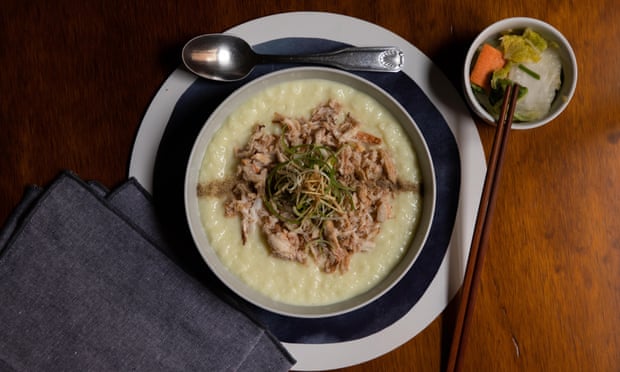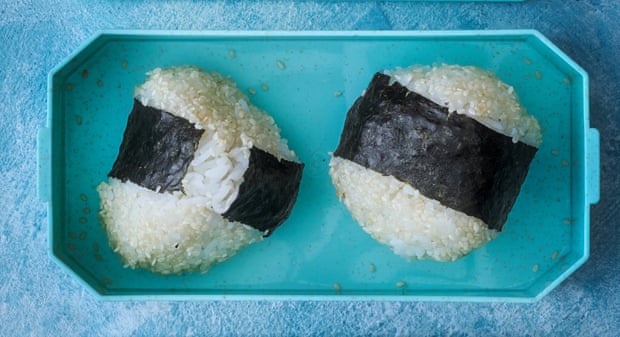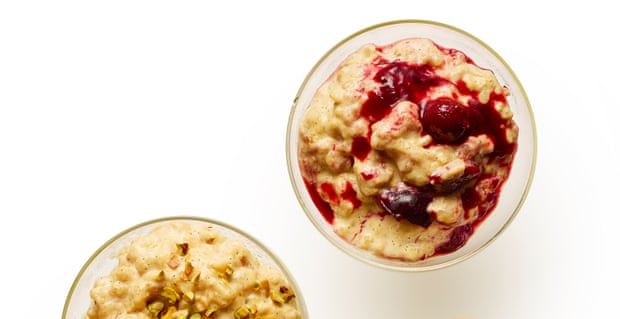Australians eat about 300,000 tonnes – or 12 kg of rice for each person – each year.
Given its long shelf life, low cost (as little as $1.40 for a kg in supermarkets), and the fact that it is flexible enough to use in sweet or savory dishes from hundreds of cuisines, this is hardly a surprise.
Here’s how to go on a round-the-world tour with one staple ingredient.
Congee and soups
To make congee, a nourishing rice porridge traditionally eaten for breakfast, chef and Trentham cooking school owner, Tony Tan uses a medium-grain rice, simmered in chicken stock.
“Use around a cup of rice to 10 cups of stock,” he says.
“Add shredded cooked chicken and any condiments from your pantry – like pickles, fried shallots or chopped spring onions and finish with a dash of soy sauce and roasted sesame oil.”

Eun Hee An’s elegant king’s congee is cooked with milk as well as stock. Although the dish comes with a royal title, its crab-meat topping can be bought canned from supermarkets for as little as $4.30 – enough to serve two with some to spare.
Rice also makes an appearance in soups like the classic Greek avgolemono, used to add body to the lemony, chicken soup, like in this one from Peter Mantis.
Rachel Roddy offers an Italianate winter warmer; rice and cabbage soup; “cheap and generous,” she says.
Risotto
Choose an Italian rice such as arborio, vialone or carnaroli when cooking risotto, says Katrina Ryan, owner and chef at Brisbane’s Golden Pig cooking school.
“Cooked in stock and stirred like a porridge, it releases its starch and results in a creamy, cohesive, wet dish with pleasantly al-dente texture right to the center of the rice.”
A good flavorsome stock, (always added hot) is vital too, she says. Cheese such as parmesan or pecorino adds richness while butter gives gloss.
“My favorite simple risotto is made by sweating lots of baby spinach in butter then blitzing to a puree and adding it to a simple onion, garlic, white wine and chicken stock risotto at the end, with the cheese and butter. Serve it with a wedge of lemon.”
Anna del Conte’s lemon risotto, scented with rosemary and sage, is enriched with eggs and cream, stirred in at the last minute.
If you have neither time nor the will to stand stirring risotto, Rachel Roddy’s minimal-stir method, with zucchini, peas and broad beans could be adapted to whatever vegetables you have to hand, or even in the freezer.
rice balls

If you wind up with leftover risotto, it’s the ideal base for upcycling into arancini, a traditional Sicilian street food of rice molded around fillings. Felicity Cloake suggests ragu, pesto or sauteed mushrooms for the center.
But not all rice balls require deep frying. Japanese lunchbox staple onigiri features a smaller quantity of filling, but is quicker and easier to make. Shuko Oda stuffs her version of her with umeboshi – pickled plum.
Vietnam has its own equivalent too, cơm nắm. Lucas Doan, head chef at Sydney’s Luna Lu, counts it as one of his favorite dishes. “When I was a child… my grandmother used to make it for me to bring to school as my snack.”
Still-warm, short grain rice is kneaded until firm, then shaped into small balls or logs, that you can eat with your hands.
“The best part is the condiments,” Doan says. “I personally like to dip my cơm nắm into a mixture of salt, sugar, and toasted sesame seeds.”
fried rice
A good fried rice starts with pre-washing the grains to remove the starch. That way it doesn’t become gluey, says Doan.
“You can use any type of long-grain rice, but I prefer Thai jasmine rice because of the texture and unique fragrance.”
“Steam it, then let it cool down,” he says. “This makes the rice firmer and easier to fry.”
Doan’s go-to starts with scrambling an egg in a hot pan with vegetable oil, then adding in the rice and cooking “for a good three to five minutes, depending on whether your rice is fridge-cool or at room temperature”.
“Season with a pinch of salt and two pinches of sugar and a small amount of unsalted butter, mixing them together well on high heat until the butter has melted. Add more seasoning if needed. Finish the dish with some fried garlic and finely chopped green shallot.”
Kylie Kwong makes an omelette topper for her fried rice; and she cooks the dish with bacon and a splash each of tamari and shao hsing wine.
Thomasina Mier’s brown rice version is topped with a crisp fried egg, and flavored with Korean staples – kimchi and gochujang chilli paste (approximately $3.20 for 170 grams at supermarkets).
Pilaf
Buttery, fluffy pilaf (or pilau) is a star side dish across cuisines stretching from south Asia to the Middle East, east Africa, the Caribbean and beyond. Katrina Ryan advises using a long-grain rice like basmati, as it will “produce a light texture with separate grains that are not at all sticky or starchy”.
“Look for an aged basmati rice for those lovely, extra-long grains.”

Anna Jones’s homely butter lemon pilaf can be eaten with a curry, a winter stew or just on its own, she says.
Studding the rice with ‘jewels’ of dried fruit, Ravinder Bhogal makes her Persian-style pilaf, with a crisp, crusted tahdig bottom. She suggests serving it with roast chicken flavored with honey and preserved lemon.
pudding

The subtle flavor of rice lends itself to desserts, too. “I use short grain arborio for making a simple milk pudding,” Tan says.
“Just simmer half a cupful of rice in two cups of full cream milk with a tablespoon of sugar, a cinnamon stick and a slice of lemon and cook until soft and creamy. You can top with sliced banana or chopped strawberries.”
Nigel Slater makes his with caramelised bananas and adds cardamom seeds to flavor the simmering rice while Felicity Cloake uses cinnamon, nutmeg, vanilla and a bay leaf.
“My mum used to substitute cooked rice for bread in a ‘bread and butter’ pudding with lots of fresh lemon zest,” says Katrina Ryan. “I absolutely loved this version… and much preferred it to white sliced bread.”